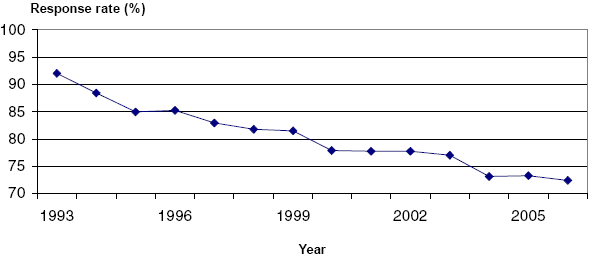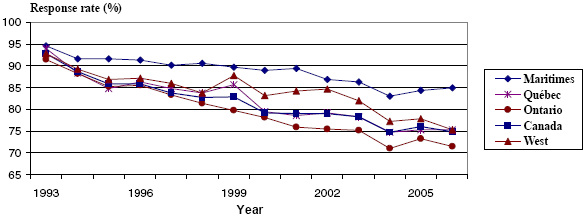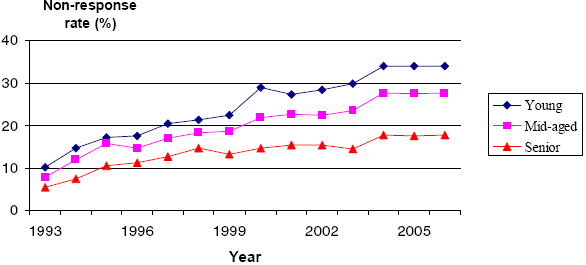Response rates
Archived Content
Information identified as archived is provided for reference, research or recordkeeping purposes. It is not subject to the Government of Canada Web Standards and has not been altered or updated since it was archived. Please "contact us" to request a format other than those available.
Since SLID has taken on the role of both a longitudinal and a cross-sectional survey, respective response rates are calculated. Cross-sectional response rates are calculated both at the person level and at the household level. Since sample persons have the option of giving tax permission thereby avoiding the income questions, it is possible to have complete data for income with no actual contact made during the reference year. Because of this the definition of a non-respondent is not straightforward.
If all persons in a household are non-respondent to both labour and income questions, then these persons (and households) are non-respondent.
With respect to those persons in households which are non-responsive to the labour questions but for whom we have tax data, it is determined whether the person is in the same household as the previous year (as of December 31). If the household is different this means the respondent has split from the original household. Since we have no information at all on the household composition of the new household, such persons are defined to be non-respondent.
Persons in households which are non-responsive to the labour questions but for whom we have income data and for whom the household has not changed since the previous year, are considered non-respondents if the household was a non-responding household to the labour questions the previous January. Since updates to household composition are collected with the labour questions, this means that the household composition has not been updated for 2 consecutive years. Persons in households that have been nonrespondent to labour questions in 2 consecutive January collections are therefore considered to be non-respondents to SLID.
Figure 5.1 shows the cross-sectional person response rates to SLID throughout the years of the survey. The person level response rates are calculated by dividing the number of cross-sectionally eligible respondents to the labour and/or income questions by the total number of cross-sectionally eligible people. An assumption is made that non-respondents are still in the target population unless there is evidence to the contrary. As a result this may somewhat underestimate response rates.
A household is considered a respondent household if at least one person in that household is considered a respondent. Household response rates are calculated by dividing the number of cross-sectionally eligible responding households by the total number of crosssectionally eligible households. Once again an assumption is made; non-responding households are assumed to be still in the target population unless there is evidence to the contrary. As a result this may somewhat underestimate response rates.
Nonresponse can potentially introduce a bias in the data. A bias is created if characteristics of respondents differ from those of nonrespondents and this difference has an impact on the variable being studied. It is difficult to determine whether nonresponse is introducing bias, because there is a limited amount of information for nonrespondents. Figure 5.2 shows the household response rates by region.
Figure 5.3 shows the longitudinal non-response rates each year by age group. 'Young' are people at least 16 years of age but less than thirty, 'Mid-aged' are people thirty years of age or older but less than sixty years of age and 'Senior' are people at least sixty years of age.
Figure 5.1 Cross-sectional person-level response rate (%)

Table 5.1 shows the person response rates by phase. 'Respondent to labour questions' and 'Respondent to income questions' are the percentages of those who responded to only the labour or income sets of questions respectively whereas the 'Respondent to both sets' is the percentage of all those who responded in full or in part to both sets of questions.
Due to the conceptual difficulty in defining a longitudinal household, only person level longitudinal response rates are calculated. Table 5.2 shows person level longitudinal response rates by panel. These rates are calculated by dividing the number of longitudinal respondents by the original number of longitudinal persons selected in that panel.
Figure 5.2 Cross-sectional household response rate (%) by region

Figure 5.3 Longitudinal non-response rate by age group

![]() Table 5.1 Cross-sectional person response rates by phase (%)
Table 5.1 Cross-sectional person response rates by phase (%)
![]() Table 5.2 Longitudinal person-level (all ages) response rates by panel (%)
Table 5.2 Longitudinal person-level (all ages) response rates by panel (%)
- Date modified:
